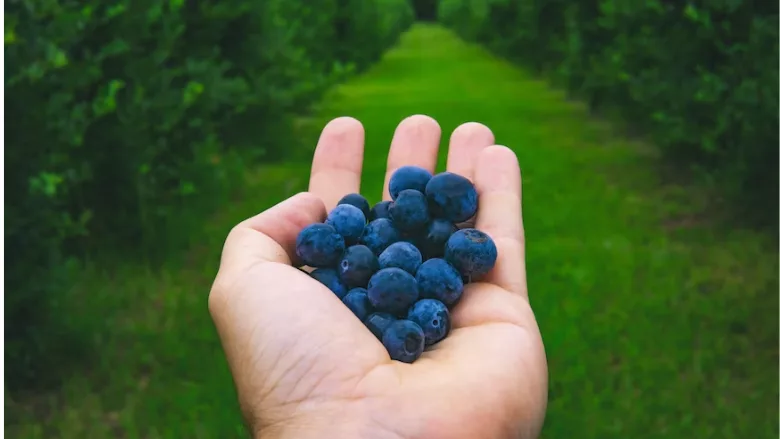Researchers Warn Polymers Used on Machine Harvesters Harbor Microbes, Pose Food Safety Risk

Image credit: Joshua Woroniecki via Unsplash
A recently concluded project funded by the Center for Produce Safety has collected information about, validated, and evaluated the efficacy of the cleaning and sanitation practices for harvest equipment among blueberry harvesters and packers. The project was carried out from January 1, 2021–January 31, 2023 by researchers from the University of Georgia and Oregon State University.
The project was conducted in order to answer questions about the different practices that blueberry growers and packers have adopted to clean and sanitize harvesting containers, flats/crates, and machine harvesters, and whether such practices do not have equal efficacies in decontaminating harvesting equipment and utensils.
Using an electronic survey that was deployed in different U.S. states, the researchers collected information on the harvesting and sanitation practices currently used by blueberry growers and packers. Over 70 respondents from 13 different states responded. Approximately 3 percent of respondents reported never sanitizing their harvest containers, while 75 percent sanitized with varying frequencies About 2 percent of respondents never sanitized their machine harvesters, and the remaining 98 percent reported sanitizing harvesters after each use, once a day, or once a week.
Next, the efficacies of current industry cleaning and sanitation practices were verified by measuring the microbial load on the surface of blueberry harvest containers and machine harvesters before and after the cleaning/sanitation treatments. Four fresh blueberry packing facilities—two in Georgia and two in Oregon—participated in the study. Each facility was randomly visited twice on two separate packing days during the 2021 harvest season. In Georgia, ten independent swab samples were collected each from used berry lugs, cleaned/sanitized lugs, used handpicking buckets, or cleaned/sanitized buckets, for a total of 160 samples. In Oregon, swab samples of used and cleaned/sanitized flats were collected along with those from used and cleaned/sanitized picking buckets, for a total of 160 samples.
On average, the used lugs and used buckets from the Georgia facilities had significantly higher total aerobes and total yeast and molds counts, but not higher total coliforms counts, than their respective cleaned/sanitized lugs or buckets. The used picking buckets from the two Oregon facilities had significantly higher mean total aerobes, yeasts and molds, and total coliform counts than the cleaned buckets. However, the used flats only had significantly higher yeasts and molds counts than the cleaned flats.
Approximately 1.3 percent of the Georgia samples tested positive for fecal coliforms and 3.8 percent of the samples tested positive for enterococci. For the Oregon samples, 3.8 percent were positive for fecal coliforms and 10.6 percent were positive for enterococci.
Finally, in a laboratory experiment, the researchers identified whether key industry cleaning and sanitizing practices can effectively remove microbial buildups and biofilm mass on materials used to manufacture harvest containers and mechanical harvesters. High-density polyethylene samples, the material used to manufacture harvest containers and picking buckets, were tested for their ability in supporting bacterial accumulation and biofilm formation by five different strains of Escherichia coli isolated from fruits, blueberry packing lines, or machine harvesters. The efficacies of cleaning and sanitizing treatments—specifically, soap, sodium hypochlorite, or water; with soaking or no soaking and with manual or machine washing—in removing the biofilms on selected materials were also determined.
Looking for quick answers on food safety topics?
Try Ask FSM, our new smart AI search tool.
Ask FSM →
Results of the biofilm formation assay showed that soaked high-density polyethylene samples had less biofilm mass than unsoaked coupons, simulated manual washing removed less biofilm mass than simulated machine washing, and that treatment with hand soap removed more biofilms than the treatment with sodium hypochlorite.
The researchers caution that, due to labor and production constraints, growers are transitioning to the use of modified machine harvesters, which often use soft elastic polymer sheets to cover hard surfaces such as catch plates to reduce physical damage to harvested fruits. However, the polymer sheets pose a potential food safety hazard, as they are hydrophobic and likely encourage a higher level of microbial buildup on machine surfaces.
Using their findings, the researchers distributed the knowledge gained to berry growers and packers to promote best industry practices for widespread adoption. The researchers suggest that a multilingual education program based on the results of the study would help improve the food safety knowledge of personnel working in the blueberry field and packing facilities.








